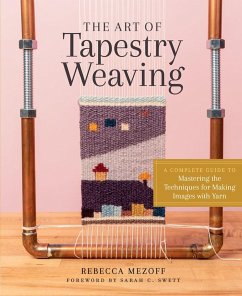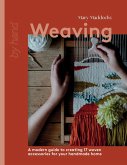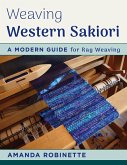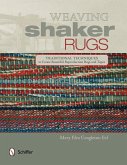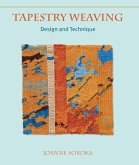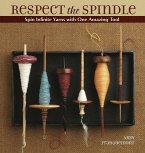Rebecca Mezoff
The Art of Tapestry Weaving
A Complete Guide to Mastering the Techniques for Making Images with Yarn
Rebecca Mezoff
The Art of Tapestry Weaving
A Complete Guide to Mastering the Techniques for Making Images with Yarn
- Gebundenes Buch
- Merkliste
- Auf die Merkliste
- Bewerten Bewerten
- Teilen
- Produkt teilen
- Produkterinnerung
- Produkterinnerung
Tapestry weaving has a fresh new look! With this in-depth technique guide and a small, inexpensive loom, fiber enthusiasts learn to create a range of images with yarn, including funky abstract designs, detailed geometric configurations, and realistic pictures.
Andere Kunden interessierten sich auch für
![Weaving Weaving]() Mary MaddocksWeaving19,99 €
Mary MaddocksWeaving19,99 €![Weaving Western Sakiori: A Modern Guide for Rag Weaving Weaving Western Sakiori: A Modern Guide for Rag Weaving]() Amanda RobinetteWeaving Western Sakiori: A Modern Guide for Rag Weaving31,99 €
Amanda RobinetteWeaving Western Sakiori: A Modern Guide for Rag Weaving31,99 €![Weaving Shaker Rugs: Traditional Techniques to Create Beautiful Reproduction Rugs and Tapes Weaving Shaker Rugs: Traditional Techniques to Create Beautiful Reproduction Rugs and Tapes]() Mary Elva Congleton ErfWeaving Shaker Rugs: Traditional Techniques to Create Beautiful Reproduction Rugs and Tapes41,99 €
Mary Elva Congleton ErfWeaving Shaker Rugs: Traditional Techniques to Create Beautiful Reproduction Rugs and Tapes41,99 €![Tapestry Weaving Tapestry Weaving]() Joanne SorokaTapestry Weaving29,99 €
Joanne SorokaTapestry Weaving29,99 €![Respect the Spindle Respect the Spindle]() Abby FranquemontRespect the Spindle19,99 €
Abby FranquemontRespect the Spindle19,99 €![Handwoven Home: Weaving Techniques, Tips, and Projects for the Rigid-Heddle Loom Handwoven Home: Weaving Techniques, Tips, and Projects for the Rigid-Heddle Loom]() Liz GipsonHandwoven Home: Weaving Techniques, Tips, and Projects for the Rigid-Heddle Loom31,99 €
Liz GipsonHandwoven Home: Weaving Techniques, Tips, and Projects for the Rigid-Heddle Loom31,99 €![Ikat: The Essential Handbook to Weaving Resist-Dyed Cloth Ikat: The Essential Handbook to Weaving Resist-Dyed Cloth]() The Weaver's StudioIkat: The Essential Handbook to Weaving Resist-Dyed Cloth33,99 €
The Weaver's StudioIkat: The Essential Handbook to Weaving Resist-Dyed Cloth33,99 €-
-
-
Tapestry weaving has a fresh new look! With this in-depth technique guide and a small, inexpensive loom, fiber enthusiasts learn to create a range of images with yarn, including funky abstract designs, detailed geometric configurations, and realistic pictures.
Hinweis: Dieser Artikel kann nur an eine deutsche Lieferadresse ausgeliefert werden.
Hinweis: Dieser Artikel kann nur an eine deutsche Lieferadresse ausgeliefert werden.
Produktdetails
- Produktdetails
- Verlag: Workman Publishing
- Seitenzahl: 320
- Erscheinungstermin: 3. November 2020
- Englisch
- Abmessung: 259mm x 214mm x 22mm
- Gewicht: 1204g
- ISBN-13: 9781635861358
- ISBN-10: 1635861357
- Artikelnr.: 58460311
- Herstellerkennzeichnung
- Libri GmbH
- Europaallee 1
- 36244 Bad Hersfeld
- gpsr@libri.de
- Verlag: Workman Publishing
- Seitenzahl: 320
- Erscheinungstermin: 3. November 2020
- Englisch
- Abmessung: 259mm x 214mm x 22mm
- Gewicht: 1204g
- ISBN-13: 9781635861358
- ISBN-10: 1635861357
- Artikelnr.: 58460311
- Herstellerkennzeichnung
- Libri GmbH
- Europaallee 1
- 36244 Bad Hersfeld
- gpsr@libri.de
Rebecca Mezoff is the author of The Art of Tapestry Weaving. An award-winning weaver and nationally known teacher of tapestry weaving, she reaches thousands of students annually through her online courses, popular self-styled weaving retreats, and in-person workshops at Penland School of Craft, Convergence, and Red Alder Fiber Arts. Mezoff has been weaving tapestries for 15 years and her articles on the subject have appeared in the American Tapestry Alliance, Spin Off, Handwoven, and Fiber Art Now. She lives in Colorado.
Foreword
Introduction: Why Tapestry?
Why Weave Tapestry?
How to Be a Beginning Tapestry Weaver
How to Use This Book
1 This Is Tapestry
Stacked like Bricks
What Tapestry Is Not
Tapestry's Storied History
Terms to Know
2 Looming Large (and Small)
Characteristics of a Good Tapestry Loom
Anatomy of a Tapestry Loom
Types of Looms
Choosing a Tapestry Loom
Approaches to Weaving
Additional Tools
3 Yearning for Yarn
Fiber Common in Tapestry Yarns
The Wonder of Wool
Yarn Terminology
Good Tapestry Yarns
Choose an Anchor Yarn
How Much Yarn?
Other Yarn Considerations
4 Only the Warped Can Weave
Why Warp Size Matters
How Weft Size Influences Your Textile
Sett Affects Image
Tips for Warping Success
Warp Length
Warping Procedures
5 Learning to See Color
You're Not "Bad" at Color
Hue and the Color Wheel
Color Harmonies
Creating Your Own Color Palette
6 Let the Weaving Begin
Parts of a Tapestry
Using Shedding Devices
Headers
7 Heading Off Trouble
Bubbling's Effect on Weft Tension
How the Loom and Beating Affect Your Selvages
8 Color Blending Magic
Creating Color Illusions with Irregular Hatching
Creating Forms with Stripes
Hachures: Formalized Hatching
9 Closing Up the Holes
Sewing Slits
Weft Interlocks
Warp Interlocks
Using Hatching for Joins
10 Angling
Straight Angles, Hills, and Valleys
Using an Uneven Number of Sequences in Each Step
Breaking Up Large Color Areas
11 Vertical Growth
Pick and Pick
Invisible Weft Sequence Join for Vertical Warp Wraps
Cutting Off the Corners to Make Vertical Curves and Angles Smoother
Other Ways to Make Vertical Lines
12 Designing
Design vs. Cartoon
Design Concepts
Making a Cartoon
Attaching the Cartoon
13 Curve Appeal
Weaving One Shape at a Time
Bottom to Top: Shape Order
Smoothing Out the Steps
Making Curved Vertical Shapes
Circles
14 Outlining
Weaving Eccentrically
Eccentric Outlines
Split Weft
15 Finish Up
Final Cleanup
Labeling Your Tapestry
Conservation Considerations
Appendices
Knots
Leashes
Making Pipe Looms
Metric Conversions
Acknowledgments
Index
Introduction: Why Tapestry?
Why Weave Tapestry?
How to Be a Beginning Tapestry Weaver
How to Use This Book
1 This Is Tapestry
Stacked like Bricks
What Tapestry Is Not
Tapestry's Storied History
Terms to Know
2 Looming Large (and Small)
Characteristics of a Good Tapestry Loom
Anatomy of a Tapestry Loom
Types of Looms
Choosing a Tapestry Loom
Approaches to Weaving
Additional Tools
3 Yearning for Yarn
Fiber Common in Tapestry Yarns
The Wonder of Wool
Yarn Terminology
Good Tapestry Yarns
Choose an Anchor Yarn
How Much Yarn?
Other Yarn Considerations
4 Only the Warped Can Weave
Why Warp Size Matters
How Weft Size Influences Your Textile
Sett Affects Image
Tips for Warping Success
Warp Length
Warping Procedures
5 Learning to See Color
You're Not "Bad" at Color
Hue and the Color Wheel
Color Harmonies
Creating Your Own Color Palette
6 Let the Weaving Begin
Parts of a Tapestry
Using Shedding Devices
Headers
7 Heading Off Trouble
Bubbling's Effect on Weft Tension
How the Loom and Beating Affect Your Selvages
8 Color Blending Magic
Creating Color Illusions with Irregular Hatching
Creating Forms with Stripes
Hachures: Formalized Hatching
9 Closing Up the Holes
Sewing Slits
Weft Interlocks
Warp Interlocks
Using Hatching for Joins
10 Angling
Straight Angles, Hills, and Valleys
Using an Uneven Number of Sequences in Each Step
Breaking Up Large Color Areas
11 Vertical Growth
Pick and Pick
Invisible Weft Sequence Join for Vertical Warp Wraps
Cutting Off the Corners to Make Vertical Curves and Angles Smoother
Other Ways to Make Vertical Lines
12 Designing
Design vs. Cartoon
Design Concepts
Making a Cartoon
Attaching the Cartoon
13 Curve Appeal
Weaving One Shape at a Time
Bottom to Top: Shape Order
Smoothing Out the Steps
Making Curved Vertical Shapes
Circles
14 Outlining
Weaving Eccentrically
Eccentric Outlines
Split Weft
15 Finish Up
Final Cleanup
Labeling Your Tapestry
Conservation Considerations
Appendices
Knots
Leashes
Making Pipe Looms
Metric Conversions
Acknowledgments
Index
Foreword
Introduction: Why Tapestry?
Why Weave Tapestry?
How to Be a Beginning Tapestry Weaver
How to Use This Book
1 This Is Tapestry
Stacked like Bricks
What Tapestry Is Not
Tapestry's Storied History
Terms to Know
2 Looming Large (and Small)
Characteristics of a Good Tapestry Loom
Anatomy of a Tapestry Loom
Types of Looms
Choosing a Tapestry Loom
Approaches to Weaving
Additional Tools
3 Yearning for Yarn
Fiber Common in Tapestry Yarns
The Wonder of Wool
Yarn Terminology
Good Tapestry Yarns
Choose an Anchor Yarn
How Much Yarn?
Other Yarn Considerations
4 Only the Warped Can Weave
Why Warp Size Matters
How Weft Size Influences Your Textile
Sett Affects Image
Tips for Warping Success
Warp Length
Warping Procedures
5 Learning to See Color
You're Not "Bad" at Color
Hue and the Color Wheel
Color Harmonies
Creating Your Own Color Palette
6 Let the Weaving Begin
Parts of a Tapestry
Using Shedding Devices
Headers
7 Heading Off Trouble
Bubbling's Effect on Weft Tension
How the Loom and Beating Affect Your Selvages
8 Color Blending Magic
Creating Color Illusions with Irregular Hatching
Creating Forms with Stripes
Hachures: Formalized Hatching
9 Closing Up the Holes
Sewing Slits
Weft Interlocks
Warp Interlocks
Using Hatching for Joins
10 Angling
Straight Angles, Hills, and Valleys
Using an Uneven Number of Sequences in Each Step
Breaking Up Large Color Areas
11 Vertical Growth
Pick and Pick
Invisible Weft Sequence Join for Vertical Warp Wraps
Cutting Off the Corners to Make Vertical Curves and Angles Smoother
Other Ways to Make Vertical Lines
12 Designing
Design vs. Cartoon
Design Concepts
Making a Cartoon
Attaching the Cartoon
13 Curve Appeal
Weaving One Shape at a Time
Bottom to Top: Shape Order
Smoothing Out the Steps
Making Curved Vertical Shapes
Circles
14 Outlining
Weaving Eccentrically
Eccentric Outlines
Split Weft
15 Finish Up
Final Cleanup
Labeling Your Tapestry
Conservation Considerations
Appendices
Knots
Leashes
Making Pipe Looms
Metric Conversions
Acknowledgments
Index
Introduction: Why Tapestry?
Why Weave Tapestry?
How to Be a Beginning Tapestry Weaver
How to Use This Book
1 This Is Tapestry
Stacked like Bricks
What Tapestry Is Not
Tapestry's Storied History
Terms to Know
2 Looming Large (and Small)
Characteristics of a Good Tapestry Loom
Anatomy of a Tapestry Loom
Types of Looms
Choosing a Tapestry Loom
Approaches to Weaving
Additional Tools
3 Yearning for Yarn
Fiber Common in Tapestry Yarns
The Wonder of Wool
Yarn Terminology
Good Tapestry Yarns
Choose an Anchor Yarn
How Much Yarn?
Other Yarn Considerations
4 Only the Warped Can Weave
Why Warp Size Matters
How Weft Size Influences Your Textile
Sett Affects Image
Tips for Warping Success
Warp Length
Warping Procedures
5 Learning to See Color
You're Not "Bad" at Color
Hue and the Color Wheel
Color Harmonies
Creating Your Own Color Palette
6 Let the Weaving Begin
Parts of a Tapestry
Using Shedding Devices
Headers
7 Heading Off Trouble
Bubbling's Effect on Weft Tension
How the Loom and Beating Affect Your Selvages
8 Color Blending Magic
Creating Color Illusions with Irregular Hatching
Creating Forms with Stripes
Hachures: Formalized Hatching
9 Closing Up the Holes
Sewing Slits
Weft Interlocks
Warp Interlocks
Using Hatching for Joins
10 Angling
Straight Angles, Hills, and Valleys
Using an Uneven Number of Sequences in Each Step
Breaking Up Large Color Areas
11 Vertical Growth
Pick and Pick
Invisible Weft Sequence Join for Vertical Warp Wraps
Cutting Off the Corners to Make Vertical Curves and Angles Smoother
Other Ways to Make Vertical Lines
12 Designing
Design vs. Cartoon
Design Concepts
Making a Cartoon
Attaching the Cartoon
13 Curve Appeal
Weaving One Shape at a Time
Bottom to Top: Shape Order
Smoothing Out the Steps
Making Curved Vertical Shapes
Circles
14 Outlining
Weaving Eccentrically
Eccentric Outlines
Split Weft
15 Finish Up
Final Cleanup
Labeling Your Tapestry
Conservation Considerations
Appendices
Knots
Leashes
Making Pipe Looms
Metric Conversions
Acknowledgments
Index

